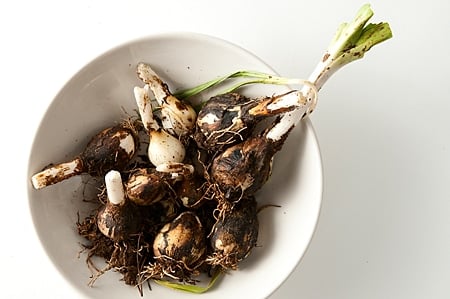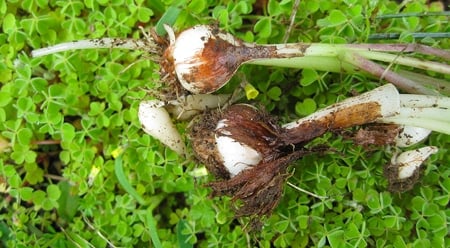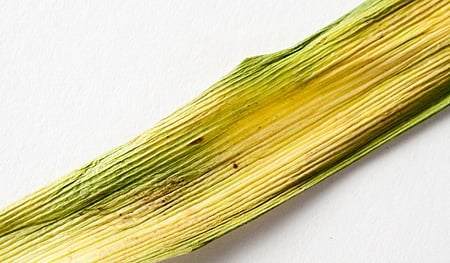As an Amazon Associate I earn from qualifying purchases.

Edible bulbs, a forager’s conundrum.
Part of what I do in my leisure time is read scientific articles about the wild food plants that live here in North America. I know. Riveting, right? And in these articles the topic of edible wild bulbs, corms and tubers comes up repeatedly. They are nutrient dense and can be as good or better than onions, our most commonly eaten bulb.
Many Native American groups used some sort of wild bulb as a matter of course, and a few groups relied on them as a main staple — notably the Western tribes who relied on the bulbs of the blue camas or the sego lily.
What you are looking at above is a bowl of the bulbs from Camassia quamash, or blue camas. It, and its Eastern cousin the wild hyacinth, have been eaten by Native American groups from British Columbia to Georgia for millennia. But few people eat these bulbs anymore. And it is not only because the knowledge of them has been lost.
To eat a bulb is to kill the plant. So even following the forager’s code — take no more than a quarter of any stand of plants — will still greatly reduce a patch of bulb plants. This is a problem with ramps back East, which in some places are being overharvested.
For my part, I know of many edible bulbs here in California I’ve never taken because I’ve never seen them in stands thick enough to justify picking. After two years of looking, several weeks ago I finally found a stand of Ithuriel’s Spear, Triteleia laxa, worthy of harvesting. But even then I hesitated.

I’ll admit it: I hesitated not only because the bulbs of these plants are only about the size of the end of your thumb, and with the stand being only about 30-40 plants, a dozen such bulbs would not be such a huge meal. No, I also hesitated because these are achingly beautiful flowers. Fact is, most edible bulb plants are stunners. Take the mariposa lily:

I could stare at this flower for hours. But by all accounts, it is delicious roasted. Its cousin, the sego lily, is the state flower of Utah in no small part because the early Mormon settlers survived off these bulbs when their crops failed. I have never seen large stands of this plant, and so haven’t had the urge to harvest them. Ditto with the edible white brodiaea, Triteleia hyacinthina, which grows abundantly around Truckee in the High Sierra.

I have, however, harvested a few bulbs from a thick stand of white brodiaea’s cousin, Dichelostemma pulchellum, also known as the wild hyacinth or “blue dicks.”

They look tasty, right? Well, I read in some guidebooks that, eaten raw, they were crunchy and sweet. So I ate one. Ew. It was gummy, stuck to my teeth, and was not very sweet at all. This is a problem with many guidebooks, which blindly pass on misinformation printed in earlier guidebooks. It is a real dilemma for a beginner, who is left at a loss about who to trust. They are nice boiled, but they are a lot of work for such a small bulb.
All of this brings us to the Queen of Bulbs here in the West, the blue camas. I love those flower stalks that look like a set of firecrackers exploding in slow motion.

Blue camas is, obviously, on the left. Her distant cousin, Zigadenus venenosus, is on the right. Common name: Death camas. Inviting, eh? This is probably the chief reason few people gather blue camas these days. Unlike the other edible members of the lily clan, camas does still grow in vast numbers throughout the Mountain West.
Even though the “camas prairies” are greatly reduced from what they were when Lewis and Clark first dined on baked camas bulbs (you can thank agriculture for that), there are still plenty enough to harvest a few meals each year.
[on_ad]
But you need to watch out for death camas, which can grow right next to Lady Blue in mountain meadows. Most foragers advise that you harvest when the flowers are in bloom, so you can’t make a mistake. But as anyone who’s eaten a carrot that’s gone to seed knows, eating a bulb when it is flowering is not ideal, culinarily speaking. You really want a bulb when the plant is storing energy in that bulb, not spending energy flowering; it will be fatter and tastier. So a good compromise is to harvest right after flowering, when the seed pods are ripening.

Here’s how to identify blue camas after the flowers are gone. First, look at the seed heads. The pods of blue camas will be roughly 1/4 inch across and a 1/2 inch long, or larger, and a blue camas will set seeds farther along the stalk than a death camas will. Death camas seed pods are usually 1/8 inch or smaller and the pods will all be bunched up at the top of the stalk.
Incidentally, if you let the stalks dry you can plant the seeds in your yard in fall. They need some chill time, so if, like me, you live in a warm winter zone, you will need to stick them in the fridge for a couple months before they will germinate.
Blue camas will, in general, be a larger plant than death camas. The exception to this is if you happen to be in a dappled shade environment or at the edge of a forest. There the camas will be stunted, and will approximate the size of a death camas. I’d recommend skipping those sites.
Another key indicator is on the leaves of the camas. Blue camas has lots of veins running parallel to the leaf. According to master forager John Kallas, there will be about 24+ veins on a blue camas leaf. Death camas leaves have only about 12 veins running along them. Both leaves have a strong “v,” like the leaves of a leek plant. The “v” in the death camas will be more brittle than on a blue camas: If you run your fingers along the blue camas leaf, the “v” will flatten out easily. It will tend to break the leaf on a death camas. Below is the leaf of a blue camas, albeit a little faded:

The size of the bulbs is also a relative indicator, although not a super-reliable one. Death camas bulbs are smaller than those of blue camas, which can get as large as 1 1/2 inches across — the size of a small onion. These are all blue camas bulbs:

Digging camas bulbs isn’t the easiest thing I’ve ever done. The bulbs are usually about 4-7 inches below the soil surface, and where Holly, Chef Jacob Burton and I dug them last weekend near Truckee, the soil was full of clay; it broke Jacob’s trowel. I did manage to gather a dozen before giving up.

Clearly a trowel is not the best tool for this. A spade is probably better. Some other tips on gathering blue camas:
- Dig only in large patches of them. Patches are often separated by a few yards, so look around in a meadow before digging. You don’t want to dig where camas is just barely holding on. You want to dig where it is thriving.
- Harvest only a few bulbs from each patch. Stick and move. Gather no more than a fourth of each patch before moving to another one — and preferably fewer than that. I was digging about 2 bulbs per little stand of 15-20 plants, then moving on.
- Go for the biggest plants. They will have the biggest bulbs.
- Leave the stalk on the bulb for now. It will help you double check that it’s blue camas before eating them. You can skip this if you are gathering camas when it is in flower.
- Clean the bulbs when you get home and stick them in the fridge. Camas bulbs spoil fast at room temperature.
Is all of this worth it? The digging, the risk of misidentifying blue camas with its poisonous look-alike, the careful harvesting — and the risk of catching Cain from people who think digging wildflowers is not much better than clubbing baby seals? That’s your choice.
I happen to like camas a lot. But even I will only harvest enough for a meal or two, and even then not every year. (Read this article if you are interested in how to cook camas bulbs.) If you do choose to harvest edible bulbs, do it responsibly.




Hi this is great! Please ad me to your newsletter. Regards from Switzerland Sabine
Has anyone heard of eating the surprise Lily’s bulb
I’ve read some talk that the Indians may have pulled Death Camas when they were in flower, not to eat of course, but to seperate them from largely blue camas patches. Has anyone else heard or done this? Perhaps transplant those deathscamas to somewhere else.
Hi,
Thanks for writing this! I was weeding my yard last weekend when I accidentally dug up a young bulb. Curious, I put it back in the ground and started investigating. I thought they were wild onions at first, as they were growing in places I knew no one would have planted them on purpose.
Finally narrowed it down to blue camas and I am excited to try them out in about a month or so!
Greetings,
Along with several friends, I have learned from a wonderful woman, Fenisha Madreno, who has been” living on the hoop” for decades. It is her life’s mission to rewild the native plants of the Great Basin area that were sacred to the native people’s there. She learned from the Shoshone women elders to only harvest bulb plants, like the camas, when they are in seed so that as you dig them the seed may fall back to the earth thus creating a cycle of regrowth. Fenisha calls this The Reach Around.
Just the other day I harvested a few bulbs. There were both Blue Cammas and Death (White) Cammas. I did check out the leaves but, both plants had Identical leaves. I even ran my fingers down the blades to see if they would split down the middle. The white (death) Cammas was just as plyable as the Blue, and no splits.
What is the best way to store these? You ?said int he fridge, but should I keep them in a bag? Do you think I could freeze them?
Great post. During the spring time I was concerned with all posts on peoples blogs about harvesting wild allium that people in the PNW would unknowingly harvest death camas. Your post serves as a great reminder to know your plants before harvesting. Thanks.
Melissa: Good point about the tending of the camas prairies! One of the reasons you don’t always find death camas in a good patch of blue camas is because the Indians pulled them out. Hadn’t thought about the idea of forest encroachment, though. Very interesting.
Josh: I didn’t find any death camas! Guess our patch had been tended before…
Don: Clearly I need to get a copy of Tending the Wild.
Nathan: I have not. Not a huge fan of puffballs. They are the tofu of the mushroom world. Fine, but boring.
Jeff: I hear ya. It’s a little tough to eat a pretty flower like that, so I only do it when there are zillions of them around.
Mojourner: Would love to see those digging sticks in action. I’ve heard they work great, but have never seen one used.
Melissa and others already said most of what I would, and together with you post are very interesting. It’s important to know that the prolific stands were part of native land management. Besides fire, there is evidence that weeding occurred in some plots, that the harvest technique aerated soils, and that many people harvested after seed set, replanting as they went and thus avoiding the problem of killing off the stand by collecting.
The technology of harvest is also worth talking about. Spades will cut and damage a lot of bulbs. In the NW where I live, tribes used digging sticks. Poke it down 6 inches or so adjacent to a bulb, then pry it up. Way easier than actual digging, and manages to aerate soil without disrupting or turning it over. I’ve seen patches that I know were harvested, but after a single rain the evidence was very subtle.
I’ve also noted that some places have larger bulbs, or have some other attribute that knowledgeable native people value. I suspect that if and when genetic studies are done, it will turn out that varieties were selected, transport/transplanting occurred, and the ‘wild’ food staples were managed much more heavily than most westerners (including scientists who write those article you peruse) know.
Thanks for the article.
Hi Hank. Great article. This is actually the first one that I’ve read which discusses wild bulbs extensively. I guess it’s another thing that makes it easier to consume onions, they don’t have beautiful flowers like these other bulbs which are more beautiful to look at than harvest.
Very cool post. Just curious if you found any mushrooms. I stumbled onto a few sierran puffballs and spring porchini last week at about 7000′ in the Stanislaus NF. Have you tried the sierran puffball?
Native American harvest of bulbs was part of an overall cultivation strategy that increased the size and number of the plants they favored. By loosing the soil, removing a few unwanted competitor plants, and replanting the small bulblets, your harvest over a few years will increase stands, individual size, ease of harvest, and hopefully lessen guilt.
Joe Beardsley directed me to the book, “Tending the Wild” by m. Kat Anderson, which details many such California Native American practices. Highly recommended.
Great post Hank. Those pictures that Holly took are beautiful. What did you end up doing with the Camas bulbs? Can we expect another post?
Very cool post! I’m still a tad nervous, but I’ll eat whatever you make.
One question: Why didn’t you bring home some examples of death camas?
: )
Thanks for shining light on the many delicious (and beautiful) wild plant foods in North America. One really interesting aspect about blue camas is that camas prairies were tended and harvested, and thus, might themselves be considered “agri-CULTURAL landscapes”. Camas prairies were often cultivated through the use of anthropogenic fire to keep prairies open. The loss of prairies is much more complicated than change brought on by agricultural land use … we have to also consider how forest regeneration (“forest encroachment”) and the exclusion of both fire and active harvesting have played roles in reducing camas prairies (not to mention urbanization, etc).
I love the way camas pushes us to think across these often-taken-for-granted binaries of wild/cultivated, forest/farm, cultural/natural landscapes. If you haven’t already, check out “Tending the Wild” and other manuscripts by M. Kat Anderson (UC Davis Ecologist and Ethnoecologist).